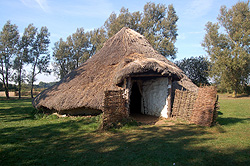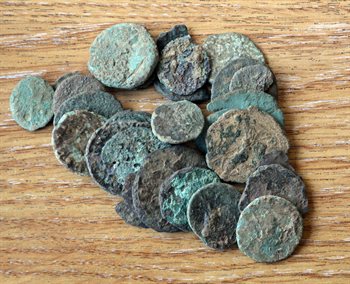Tempsford Before 1086
The Bedfordshire Historic Environment Record [HER] contains information on the county's historic buildings and landscapes and summaries of each entry can now be found online as part of the Heritage Gateway website.

A reconstruction of an Iron Age hut at Flag Fen October 2011
The earliest evidence of human activity in this parish takes the form of prehistoric metalwork, several examples of which have been discovered around the former gravel pits between Tempsford, Blunham and Sandy and around the River Ivel. Other finds have included Palaeolithic, Mesolithic and Neolithic flint axeheads and picks (HER 14661-14669 and HER 490-491) as well as flint flakes (HER 1387) and scrapers (HER 18438). There is also evidence of Iron Age activity in the north-west of Tempsford Park, with excavations there having uncovered flint and pottery, ditches, beam slots and post settings [HER 19765]. An intact pot made of local shell tempered ware, thought to be an Iron Age cremation vessel, was uncovered near Stonebridge Farm [HER 16047].

An assemblage of Roman coins
In 1961, deep ploughing at a site just south of Tempsford and close to the A1, uncovered a number of Romano-British finds, including building debris, pottery and metalwork such as coins, knives and brooches. Evidence of burnt debris and kiln waste suggested that pottery was manufactured on-site but that it may have been burnt and vacated without warning. Excavations did not uncover any buildings although aerial photography identified the potential location of a villa with a mosaic floor nearby [HER 801]. A great many of the finds were stolen from the site during the excavations.
In 917AD Tempsford briefly became the site of a Danish settlement when, according to the Anglo Saxon Chronicle, the Danes built a defensive fort as a base for attacks on English territory. It was here that Danish chieftain, Earl Toglos, met his death during an attack by King Edward the Elder in that year. Evidence of Anglo-Saxon occupation has been discovered at Tempsford Park (HER 19766) and at Ouse End (HER 19368) but there’s no visible evidence of the Danish presence in the village. It was been speculated that Gannocks Castle, a motte and bailey fortified manor house built in the late 12th or early 13th century, was built on the site of the Danish fort but this has never been proven. The earthworks and moat are all that remain of the medieval castle (HER 761). Restoration works took place from 1998 and the site was opened to the public in 2006.